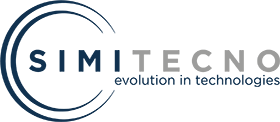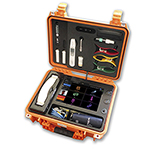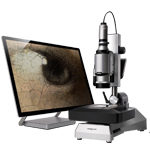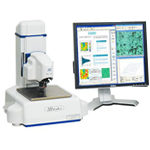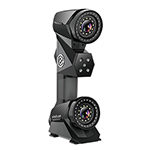COVID-19 Science Report: Diagnostics

Diagnostics
laboratory diagnosis plays an important role in disease and outbreak management. Fast and accurate laboratory diagnosis of a specific viral infection of interest contributes to prompt public health surveillance, prevention, and control measures.
With wide accessibility and availability of an accurate laboratory diagnosis for early detection, local transmission and clusters can be prevented or at least delayed by isolating the laboratory-confirmed cases in a healthcare facility, and to have their close contacts quarantined and monitored at home.
Furthermore, this facilitates the implementation of specific public health intervention such as the closure of specific high-risk facilities and areas associated with the laboratory-confirmed cases for prompt infection control and environmental decontamination.1,2
Current Diagnostics
Appendix A is a summary of the latest non-commercial laboratory diagnostic protocols listed on WHO’s COVID-19 webpage, available or upcoming commercial, non-commercial diagnostics, and summary of approaches for laboratory diagnostics of coronaviruses by Zhang et al (2020,3 as well as the gene targets and specimen sample types tested with polymerase chain reaction (PCR) as reported in publications on clinical cases of COVID-19. Diagnostics that can be used for point-of-care testing have been noted in Table 2 in the first column.
Detection of Viral Genetic Material
Chinese health authorities have posted the full genome of SARS-CoV-2 in GenBank and GISAID portal. 1 Several lab assays have been developed to detect SARS-CoV-2, as highlighted in WHO’s guidance to COVID-19 laboratory testing of suspected cases. WHO first published five protocols for diagnostics using reverse transcriptase polymerase chain reaction (RT-PCR) on their COVID-19 webpage. These included protocols from Charité Institute of Virology in Germany and The University of Hong Kong (HKU), as well as those from Thailand, Japan, and China. A sixth protocol from US Centers for Disease Control and Prevention (CDC) was subsequently added on WHO’s webpage on 29 January 2020.4The WHO webpage has since been updated with a different URL and with additional guidance documents.5 A seventh protocol from Institut Pasteur in Paris, France, was added on WHO’s webpage in March 2020.
It should be noted that the protocols for diagnostics using RT-PCR published on WHO’s webpage is for guidance and not an exhaustive list. Various institutions and governments have chosen to develop their own protocols that might not be publicly available or published by WHO on their webpage.
As outlined in the sixth national treatment and diagnostic plan issued by China’s National Health Commission, the diagnosis of COVID-19 still requires the detection of the genetic material of SARS-CoV-2 before classification as a confirmed case. 7
The first validated diagnostic test was designed by Prof Christian Drosten’s group from Charité Institute of Virology in Berlin, Germany.1,8 The initial RT-PCR assay design was based on the SARS-CoV or SARS-related coronavirus, but with the release of the sequence, assays were selected based on the match against the Wuhan virus. Two assays were used for the RdRP gene and E gene where E gene assay acts as the first-line screening tool and RdRp gene assay as the confirmatory testing. All assays were highly sensitive and specific, and do not 2 cross- react with other coronavirus and also human clinical samples that contain respiratory viruses.
HKU uses two monoplex assays reactive with coronavirus under the subgenus Sarbecovirus which consist of SARS-CoV-2, SARS-CoV, and SARS-like coronavirus.9,10 Viral RNA extracted from SARS-CoV could be used as the positive control. The N gene RT-PCR could be used as a screening assay and Orf1b assay as a confirmatory test. However, this protocol has only been evaluated with a panel of controls and only positive control, SARS-CoV RNA. Synthetic oligonucleotide positive control or SARS-CoV-2 have yet to be tested. This protocol has since been published in Clinical Chemistry on 31 January 2020.
10 US CDC has shared the protocol for rRT-PCR assay with the primers and probes designed for the universal detection of SARS-like coronavirus and the specific detection of SARS-CoV2.11,12 However, the protocol has not been validated in other platform or chemistries apart from the protocol described, and the analyst has to be trained and familiar with the testing procedure and result interpretation.
As of 4 February 2020, US CDC has obtained emergency use assessment (EUA) from the US Food and Drug Administration (FDA).13
This allowed US CDC to ship their diagnostic test kits to laboratories that are designated by CDC as qualified or certified under the Clinical Laboratory Improvement Amendments (CLIA) to perform high complexity tests in the US.
With the shipped US CDC diagnosis kits, however, quality control issues were found with reagents pertaining to the third step N3 gene assay for universal detection of SARS-like coronaviruses. 14 As such, US CDC is reportedly producing new test kits, and that those with existing kits were provided with new guidelines to continue without the third step N3 gene assay.15,16 An investigation has also been launched, with major concerns raised in the preliminary stages.17,18 The US Food and Drug Administration (FDA) has since announced on 29 February 2020 a change in policy for certain laboratories to develop and begin using validated COVID-19 diagnostics (other than the only EUA-approved US CDC) before the FDA has completed the EUA review.17,19
As of 17 March 2020, six companies have obtained EUA approvals from US FDA for their commercial RT-PCR diagnostics: Roche, 20 Thermo Fisher Scientific,21 Hologic,22,23 LabCorp, 23 Quidel,24 and Quest Diagnostics. 25 IDT26 and LGC, Biosearch Technologies27 also have specific lots of their RT-PCR diagnostic kits approved for EUA by US FDA.
Currently, most of the available diagnostics have focused on packaging the appropriate reagents and genetic primers and probes for using RT-PCR to amplify genetic material for detection of SARS-CoV-2. Additional methods include using microarray or microfluidic lab-onchip technologies, CRISPR to isolate gene segments for diagnostics, and full genetic sequencing. The use of microarray or microfluidic technologies for miniaturised fast detection of genetic material in some instances could be considered to be rapid point-of-care testing, as samples could be run on miniaturised and/or automation machinery instead of a full laboratory. However, the caveat would be that the accompanying machinery and reagents are widely distributed and available across different sites and/or in the field.
Serological Testing
For diagnosis of acute infections, there is a lag period as antibodies specifically targeting the virus would normally appear between 7-14 days after the illness onset. However, serological tests can be used to assess both active and historical infection within the community. Serological tests using immunoassay test strips can also provide rapid point-of-care qualitative detection of antibodies for better screening before further confirmatory tests.
Singapore has developed an approach of using serological testing to diagnose cases that earlier had COVID-19. 28,29 This test for the antibodies for SARS-CoV-2 was developed by Prof Wang Linfa’s group in Duke-NUS Medical School. 3
Rapid IgM antibody test strips have been developed by Guangzhou Medical University under the guidance of famed researcher Dr Zhong Nanshan and are already in use in China.7,30 Guangzhou Wondfo Biotech and Innovita Biological Technology have already received EUA approvals from the China National Medical Products Administration for their antibody test kits.31-34 Guangzhou Wondfo Biotech has also obtained CE Mark for their Wondfo SARS-CoV2 Antibody Test (Lateral Flow Method) that tests for both IgM and IgG antibodies. 35,36 Pharmact AG from Germany, 37 Zhejiang Orient Gene Biotech,38,39 and SD Biosensor40 have commercially available immunoassay test strips for qualitative detection of antibodies that can be used for point-of-care testing. Other rapid test kit development and commercialisation efforts by Jiangsu Medomics Medical Technologies,41 Shenzhen Tisenc Medical Devices, 42 and Nankai University43 are also underway. These test strips are all expected to take about 15 to 20 minutes, a major time reduction compared to using RT-PCR.
Jiangsu Medomics Medical Technologies (China-based sister company of BioMedomics, USA) have created a point-of-care lateral flow immunoassay that simultaneously detects both IgM and IgG antibodies against SARS-CoV-2, named COVID-19 IgM/IgG Rapid Test. 41 In a published Journal of Medical Virology paper by Li et al (2020), the team found a sensitivity of 88.66% and specificity of 90.63% through testing samples from 397 positive case patients and 128 negative control patients.44 The use of whole blood (diluted with buffer to improve flow) can be used and can produce results within 15 minutes. Comparison of fingerstick whole blood with both plasma and serum from venous blood found no differences in results for 7 positive case patients and 3 negative control patients. By using both IgM and IgG, the test can be used for detection of patients at different infection stages.
Over 500,000 of the COVID-19 IgM/IgG Rapid Test was reported to have been sold in China, and are currently being sold in Italy having received CE Mark for in vitro diagnostics (IVD) on 8 March 2020. 45 BioMedomics is seeking to obtain EUA approval from US FDA.
46,47
Imaging
In the sixth national treatment and diagnostic plan issued by China’s National Health Commission, cases diagnosed using chest CT Scans were not continued as part of the count of new confirmed cases. 7 China had previously announced that they would include in the count of COVID-19 cases, those that were diagnosed using chest CT Scans.48 This was due to the limited diagnostic kits and resources for testing of SARS-CoV-2 genetic material. This proposed method of early diagnosis has been explored and published in the Radiology journal. 49,50 Some studies have indicated, albeit with small samples, that CT scans could show indications of COVID-19 before onset of symptoms or positive RT-PCR test.51-53 Alibaba has also developed an artificial intelligence (AI) model using data from 5000 confirmed cases that has 96% accuracy rate in detecting differences in chest CT scans to distinguish patients with COVID-19 vs ordinary viral pneumonia.54
Issues with Diagnosis Approaches
Specimen Sample Collection
The sites of biological sampling can affect the sensitivity of diagnostic tests relying on detection of genetic material. A previous study by Kim et al (2011) has found that detection strengths of using nasopharyngeal (nasal) or oropharyngeal (throat) swabs differ for different pathogens infecting the respiratory tract, and that not one is superior than the other for all cases. 55
For SARS-CoV and MERS-CoV, specimens collected from the lower respiratory tract such as sputum and tracheal aspirate have higher and more prolonged levels of viral RNA. MERSCoV viral load is also higher for severe cases and has longer viral shedding as compared to 4 the mild case. Although upper respiratory tract specimens such as nasal or throat swabs could be used, it has a lower viral load and could result in false-negative tests among the mild cases.56,57 This is one key characteristic that may be similar to SARS-CoV-2.
Current recommendation by US CDC requires the use of BOTH nasal and throat swabs to obtain specimen from upper respiratory tract of potential case with COVID-19 for diagnostic testing using RT-PCR.58 However, initial rapid guidelines from China only indicated the use of throat swabs.59
Latest published findings from Yang et al (2020) specific for COVID-19 have found that testing of specimens obtained from nasal swabs, as well as from sputum, are more effective than throat swabs, for the detection of SARS-CoV-2.60 The authors warned that “throat swabs were not recommended for the viruses detection, especially the samples collected 8~14 and ≥15 days after onset of illness (d.a.o.) from mild cases, which may result in a large proportion of false negative results.” The authors concluded that “sputum is most accurate for laboratory diagnosis of (COVID-19), followed by nasal swabs, while throat swabs was [sic] not recommended for the diagnosis.” However, the authors recognised the limitation that preliminary investigations found that only about a quarter of COVID-19 patients showed had production. Interestingly, the authors found that for severe cases, bronchoalveolar lavage fluid (BALF) had 100% positive detection rate while specimens from upper respiratory tract (sputum, nose swab, and throat swab) did not have as strong detection rates.60
This might be a case whereby the severe cases reflect the deep infection of the lower respiratory tract, causing the pneumonia-like symptoms. The use of only nasal or throat swabs to get at an official diagnosis could thus prove to be frustrating, particularly when specimens from the upper respiratory tract might show a negative result even though all clinical signs indicate otherwise. This could cause delayed diagnosis, containment actions, and treatment regimes, and as such, the recommendation of CT scans as an added layer.
On the contrary, the small sample of three patients that were mild cases with BALF tested had 0% positive detection. It could be these cases are mild because the SARS-CoV-2 did not infect the lower respiratory tract but remained in the upper respiratory tract, which allowed for better detection if using samples from sputum or nasal swabs.
A limitation of the Yang et al (2020) study was that it was conducted with COVID-19 patients that have already been admitted to the hospital and started on antiviral treatments. 60
Their findings might thus be limited in being fully applicable to the scenario of diagnosis of potential cases. However, the study does also raise questions on the risk of false negatives leading to early discharges out of isolation and quarantine of existing diagnosed cases. To note, nasal and throat swabs: could cause discomfort and even bleeding would require experienced healthcare provider to administer could risk exposure to healthcare provider does not obtain specimens from lower respiratory tract A study by To et al (2020) have found that SARS-CoV-2 was detected in saliva samples from 11 out of 12 COVID-19 patients.61
This suggests that saliva samples could be a potential alternative or additional specimen for diagnostic testing, especially in scenarios with limited trained healthcare providers outside of the hospital setting, and with aim to reduce exposure risk during specimen collection.
As of 9 March 2020, Hong Kong has launched an initiative to have private general practitioners (GPs) and family doctors help collect deep throat saliva samples from potential cases with COVID-19. 62 The initiative to collect saliva samples is in light of the lack of protective gear by private doctors to collect nasal swabs.
This initiative aims 5 to improve community surveillance through expanding testing sample collection beyond that currently done at 17 public hospitals and 64 government-run outpatient clinics. Gene Target Choices In addition to different types of specimen samples being collected by different healthcare teams across institutions and nations, the gene targets of choice and PCR protocols used also differs.
Table 4 in Appendix A presents a summary of the gene targets and specimen sample types tested with PCR as reported in selected publications on clinical cases of COVID-19 published before 7 March 2020. Search Method Searches have been conducted for the latest information related to diagnostics for COVID-19 (previously 2019-Novel Coronavirus or 2019-nCoV) since 28 January 2020.
Searches were done on Pubmed and Google Search using key words that included: coronavirus; Wuhan; diagnostic; diagnostics; diagnosis; diagnoses; novel coronavirus; 2019 novel coronavirus; 2019-nCoV; COVID-19; SARS-CoV-2.
Google Search results reviewed included webpages of: government and international bodies with official information and guidelines (WHO, Europe CDC, US CDC, US FDA), diagnostic protocols, scientific commentaries, market news, and press releases.
All relevant links in the webpages were reviewed and relevant information used and referenced. A latest list of potential commercial kits in the works was also provided on 29 January 2020 by Dr Kim J Png through personal communications.
This list was compiled by Dr Png from web searches and review of latest business news. The list served to verify and supplement our team’s own search above for review. Subsequently, a list of biomedical news sites (Bioworld, Genetic Engineering & Biotechnology News, GenomeWeb/360Dx, Verdict Medical Devices) were also reviewed regularly as “go-to” sites to provide latest updates on commercial diagnostics developments. To note, the latest information of diagnostics being used and developed in China remain scarce or difficult to review (in Chinese, not indexed in non-Chinese search engines, or not reported in non-Chinese media news outlets). Therefore, China news sources in English language (CGTN, ChinaDaily, Global Times) were used.
